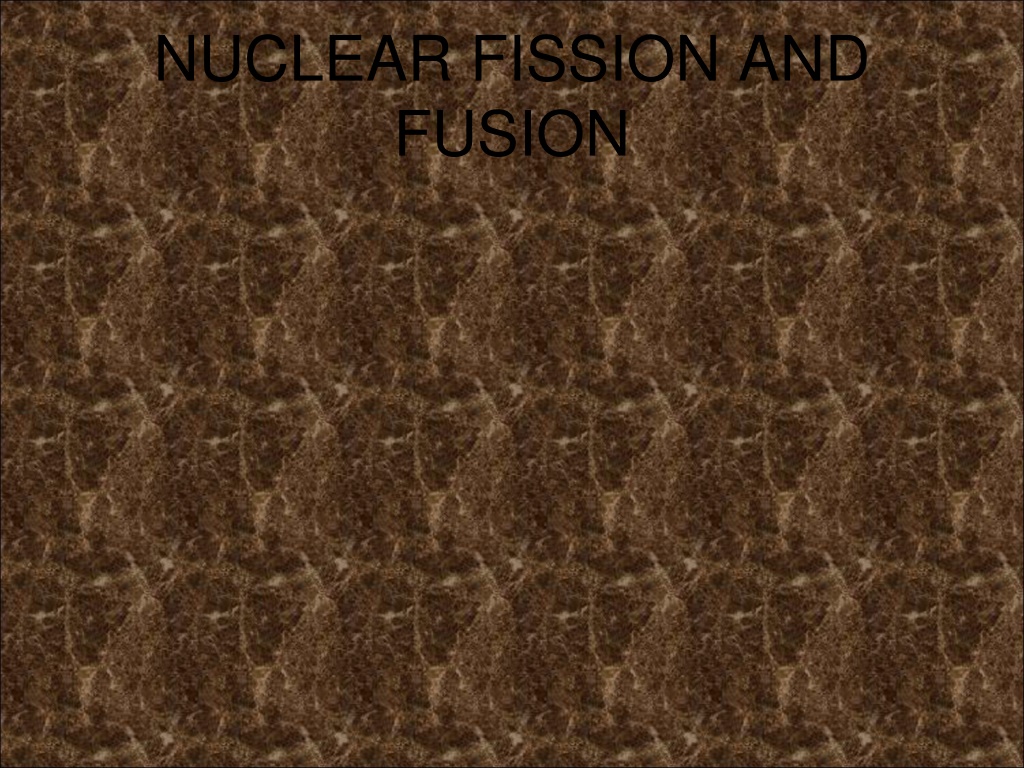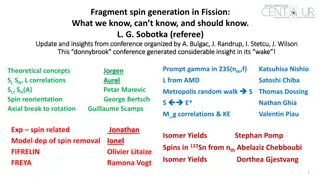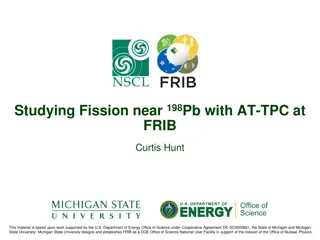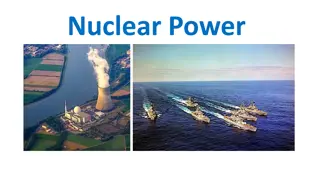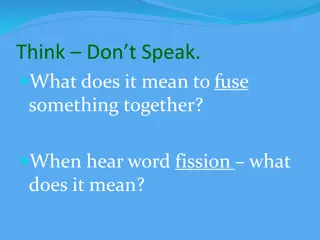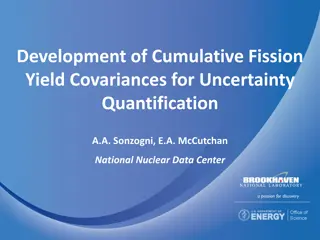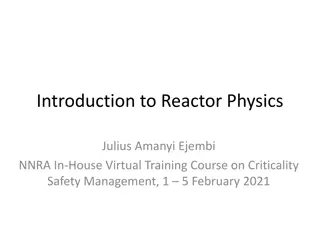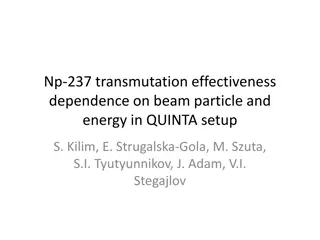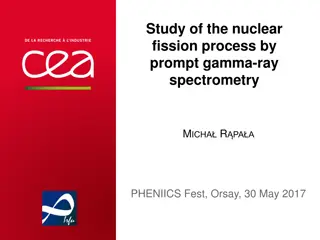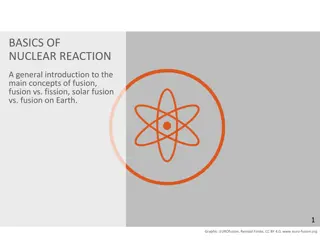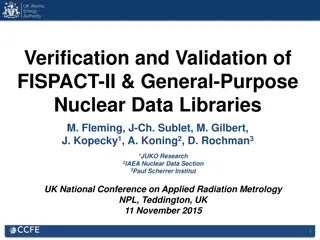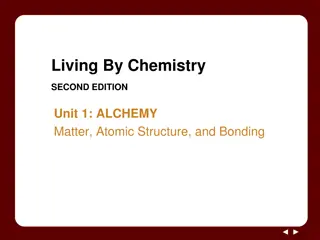Understanding Nuclear Fission: Process, Examples, and Energy Generation
Nuclear fission involves the splitting of an atomic nucleus, with uranium-235 being a commonly used fissile material. When uranium-235 undergoes fission, it produces fission fragments, neutrons, gamma radiation, and kinetic energy. The fission process can be initiated by absorbing a slow-moving neutron, leading to the production of daughter nuclei, such as barium-144 and krypton-89. Additionally, other fission products like xenon-134 and strontium-90 can also be generated. The role of control rods and moderators in nuclear fission as an energy source for generating electricity is essential for maintaining a controlled chain reaction.
Download Presentation

Please find below an Image/Link to download the presentation.
The content on the website is provided AS IS for your information and personal use only. It may not be sold, licensed, or shared on other websites without obtaining consent from the author. Download presentation by click this link. If you encounter any issues during the download, it is possible that the publisher has removed the file from their server.
E N D
Presentation Transcript
NUCLEAR FISSION AND FUSION
Specification Radioactivity and particles Particles describe the results of Geiger and Marsden s experiments with gold foil and alpha particles describe Rutherford s nuclear model of the atom and how it accounts for the results of Geiger and Marsden s experiment and understand the factors (charge and speed) which affect the deflection of alpha particles by a nucleus understand that a nucleus of U-235 can be split (the process of fission) by collision with a neutron, and that this process releases energy in the form of kinetic energy of the fission products understand that the fission of U-235 produces two daughter nuclei and a small number of neutrons understand that a chain reaction can be set up if the neutrons produced by one fission strike other U-235 nuclei understand the role played by the control rods and moderator when the fission process is used as an energy source to generate electricity.
Nuclear fission Nuclear fission is the splitting of an atomic nucleus. The process of nuclear fission was discovered in 1938 by Lise Meitner, Otto Hahn and Fritz Strassmann. Lise Meitner 1878-1968 Otto Hahn 1879-1968
Fissile materials A fissile material easily undergoes fission. The mostly commonly used fissile material is uranium-235. When this undergoes fission two daughter nuclei are produced that are called fission fragments. The process also produces neutrons, gamma radiation and a considerable amount of kinetic energy.
The fission of uranium-235 The fission of a nucleus uranium-235 can be initiated by its absorption of a slow-moving neutron. 235 236 1 + n U U 0 92 92 Uranium-236 is very unstable and splits apart. 236 144 89 1 0 + + 3 + U Ba Kr n 92 56 36 0 0 fission fragments barium-144 and krypton-89
Other fission examples Other fission products can be produced. Their masses usually have a roughly 3:2 ratio. 236 134 90 1 0 + + 2 + U Xe Sr n 92 fission products = xenon-134 and strontium-90 54 38 0 0 Plutonium-239 is also fissile. 239 137 89 1 0 + + 3 + Pu Cs Y n 94 fission products =caesium-137 and yttrium-89 55 39 0 0
Fission equation questions Complete the equations below: 236 143 91 1 0 + + 2 + U Cs Rb Rubidium n A 37 B 239 145 92 C 1 0 + + 2 + Pu Ba Sr n 38 D 235 131 91 1 0 E + + 3 + U I Y n 53 F Iodine This last example combines the uranium-235 neutron absorption with the fission of uranium-236
Fission equation questions Complete the equations below: 236 143 91 1 0 + + 2 + U Cs Rb Rubidium n A 92 55 37 0 0 B 239 145 92 C 1 0 + + 2 + Pu Ba Sr n 94 56 38 D 0 0 235 131 91 1 0 E + + 3 + U I Y n 92 53 F 39 0 0 Iodine This last example combines the uranium-235 neutron absorption with the fission of uranium-236
Chain reaction The fission of a nucleus of Uranium-235 can be initiated by a slow-moving neutron. When this nucleus splits further neutrons are produced. These neutrons in turn can cause more nuclei to split. An avalanche effect, called a chain reaction can then occur.
Nuclear fission reactors A nuclear reactor is used to produce substantial and controllable energy from nuclear fission. The thermal energy produced is used to convert water to high pressure steam. top view of a nuclear reactor This steam is used to drive turbines which rotate generators to produce electricity.
Structure of a reactor
What each part does 1. Uranium fuel rods These contain enriched uranium. This consists of uranium-238 with a higher proportion of uranium-235 than is found in natural reserves of uranium. The fuel rods become very hot and dangerously radioactive due to nuclear fission. 2. Removable control rods Made of boron or cadmium, when placed in- between the fuel rods these absorb neutrons and so reduce the rate of fission. Their depth is adjusted to maintain a constant rate of fission. uranium fuel rods 3. Moderator (graphite core) Made of graphite. This surrounds the fuel rods and slows the neutrons down to make absorption of neutrons by uranium-235 more likely.
4. Coolant This can be water, carbon dioxide gas or liquid sodium. This transfers the thermal energy of the fuel rods to the heat exchanger. 5. Heat exchanger Here water is converted into high pressure steam using the heat energy of the coolant. 6. Concrete shield This absorbs the radiation coming from the nuclear reactor. reactor underneath water coolant
Choose appropriate words to fill in the gaps below: Nuclear fission is the _________ up of the nucleus of an atom into two smaller nuclei. Energy, neutrons and _________ radiation are also emitted. Nuclear ________ use Uranium _____ or Plutonium _____to produce energy by nuclear ________. A controlled chain reaction is maintained by the use of _______ rods which absorb some of the _________ produced. An _______ bomb is the consequence of an uncontrolled chain reaction. WORD SELECTION: reactors gamma 239 fission atomic splitting neutrons 235 control
Choose appropriate words to fill in the gaps below: Nuclear fission is the _________ up of the nucleus of an atom into two smaller nuclei. Energy, neutrons and _________ radiation are also emitted. splitting gamma Nuclear ________ use Uranium _____ or Plutonium _____to produce energy by nuclear ________. A controlled chain reaction is maintained by the use of _______ rods which absorb some of the _________ produced. neutrons reactors 235 239 fission control An _______ bomb is the consequence of an uncontrolled chain reaction. atomic WORD SELECTION: reactors gamma 239 fission atomic splitting neutrons 235 control
Nuclear fusion Nuclear fusion is the joining of two atomic nuclei to form a larger one. Hydrogen nuclei undergo fusion in stars to make helium nuclei
Energy from fusion Nuclear fusion is the process by which energy is released in the Sun and other stars. It is also the energy source of the hydrogen bomb.
Nuclear fusion reactors Scientists are currently working to make nuclear fusion reactors. The fuel for fusion reactors is the isotope hydrogen 2 (deuterium) which is found in sea water. An experimental fusion reactor in Seatle USA
